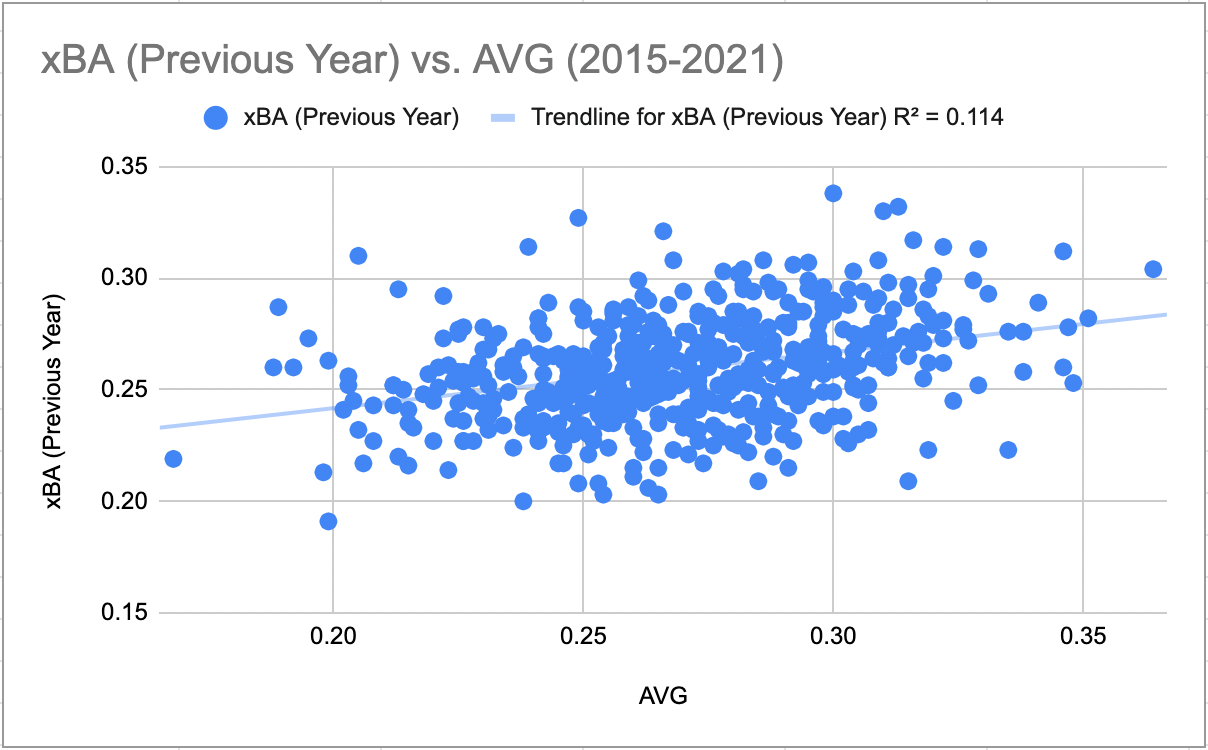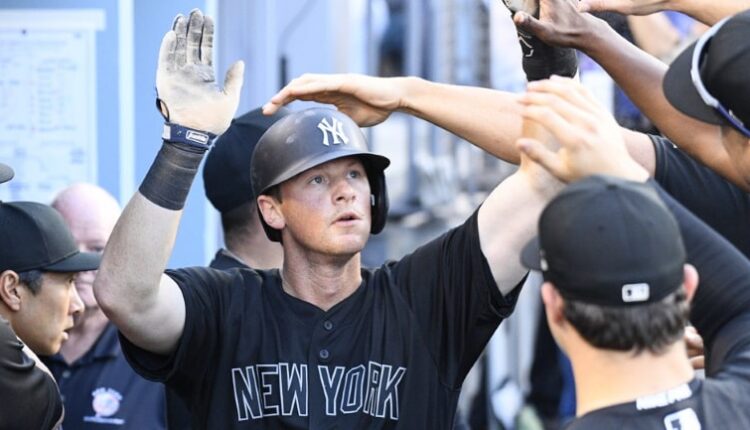I publish a regular article titled “Statcast Standouts” during the regular season. You can find those articles here if you are interested. In each of those articles, I break down players who stand out based on statcast data from Baseball Savant. I try to explain why each stat in those articles is practical and helpful for Fantasy Baseball analysis. Today we are going to discuss expected stats.
It is possible you have used expected stats to help formulate opinions on players this offseason. Baseball Savant and Fangraphs are both likely a resource you use when evaluating players. You may see stats on those websites that you do not know what they mean. This article series has the intention to help you learn more about specific statcast data and other stats and how you can use that data to analyze players for Fantasy Baseball. It is important to note that a player’s statcast profile does not paint the entire picture. It is just another tool in the toolshed. So, let’s look at a couple of stats and how they are practical for Fantasy Baseball.
Expected Stats: What Are They and Are They Useful?
Expected Stats
You often hear it quoted “Player X is overperforming his xBA, therefore regression is coming.” I have been guilty of this myself. I have written articles in the past about over and underperformers in expected stats. I look back and realize I probably had it all wrong.
Expected stats are like the shiny toys that everyone loves. People love quoting these like they are gospel and can predict a player’s performance will pick up or slow down based on these. But what is the intended purpose of expected stats and what do they tell us?
Expected Batting Average
Expected Batting Average (xBA) is a statcast metric that measures the probability that a batted ball will become a hit. Every batted ball is assigned an xBA on comparable hit balls in terms of exit velocity, launch angle, and on topped or weakly hit balls, sprint speed.

In the game feed picture above, you can see this played out. Each batted ball is assigned that xBA based on the factors mentioned in the previous paragraph. Using the expected outcomes of each player’s batted ball helps form their season-long xBA. Strikeout totals are factored into the equation, resulting in a player’s overall Expected Batting Average.
A player’s xBA for the season is calculated by taking the sum of all xBA from individual batted ball events. The sum is then divided by all batted ball events. After that, strikeouts are factored in which results in a season-long Expected Batting Average.
Fantasy Implications:
Expected Batting Average can help give us a better picture of a player’s true skill level than batting average itself. xBA removes defense from the equation, meaning the results are based more on the hitter’s skill level. Because hitters can influence exit velocity and launch angle to an extent, xBA is useful. Once the ball leaves the bat, a hitter has no control over the outcome.
Before 2020, I was able to identify Marcell Ozuna as a sleeper hitter thanks to having the largest differential in BA and xBA. Ozuna had a disappointing 2019 season, only hitting .241, but his xBA suggested he was unlucky and pegged him as a .291 hitter. Then in 2020 Ozuna mashed the ball in Atlanta and posted a .338 batting average with 18 home runs in just 267 plate appearances.
On the flip side you see some players that constantly over or underperform their Expected Batting Average, which means it is not extremely useful for every player.
There is also not much predictive value in xBA. While you get the occasional 2020 Marcell Ozuna, you get plenty of players who don’t live up to their previous season’s xBA. Looking year-over-year stats since 2015, a player’s previous season batting average is actually more predictive than Expected Batting Average.

 Looking at half-year splits, neither batting average or Expected Batting Average is that precitive, likely due to small splits.
Looking at half-year splits, neither batting average or Expected Batting Average is that precitive, likely due to small splits.
Expected Batting Average can be a useful statcast metric to use when evaluating what should have happened. It does not tell us what we can expect in the future. Using xBA to predict a change in a player’s performance may not always be the smartest thing to do.
Expected wOBA
Much like Expected Batting Average, Expected Weighted On-base Average is calculated similarly. Statcast data like exit velocity and launch angle are used. Still, xwOBA takes it a step further and assigns each batted ball a single, double, triple, or home run probability based on the results from comparable batted balls since statcast was implemented in 2015.
All hit types are valued similarly for xwOBA as they are for wOBA. The formula for wOBA is: (unintentional BB factor x unintentional BB + HBP factor x HBP + 1B factor x 1B + 2B factor x 2B + 3B factor x 3B + HR factor x HR)/(AB + unintentional BB + SF + HBP). “Factor” that you see listed in the formula indicates the adjusted run expectancy of a batted ball event in the context of the whole season.
A player’s season-long xwOBA is calculated based on the batted ball data mentioned and factors such as walks, strikeouts, and hit-by-pitch. xwOBA is based on the batter’s quality of contact rather than actual outcomes and can be more useful.
Fantasy Implication
xwOBA is less useful for Fantasy Baseball purposes in general. It is however more useful in OBP leagues, which are becoming increasingly popular in the Fantasy Baseball community. Did a hitter’s xwOBA suggest they under or overperformed? It is possible to see positive or negative regression the following season.
xwOBA has a slightly stronger predictive value of a player’s future wOBA, than Expected Batting Average does. The r2 value for previous year xwOBA to wOBA is .218 using seven years worth of data points. Previous seasons wOBA is much less predictive with an r2 of .191. Despite that, it seems that year-over-year wOBA is easier to predict than batting average.
Expected Slugging Percentage
Again, as the previous two stats mentioned, Expected Slugging Percentage is a statcast metric calculated using launch angle, exit velocity, and on certain batted ball types, sprint speed. All hit types are calculated and valued similarly for xSLG as they are for standard slugging percentage. Doubles are worth twice as much, triples three times as much, and home runs four times as much as singles.
The formula for slugging percentage is: (1B + 2B*2 + 3B*3 + HR*4)/AB). Knowing the expected outcomes of each individual batted ball from a player helps formulate the player’s xSLG. Like the other statcast metrics, Expected Slugging Percentage is based on the quality of contact rather than actual outcomes.
With seven years of statcast data to this point, it is easy to compare individual batted balls. If a single batted ball is close to other batted balls based on exit velocity and launch angles, it is easy to quantify. If you have a batter ball that has an exit velocity of 108 miles per hour and a launch angle of 21 degrees, but it ends in a flyout, that batted ball gets a zero in the slugging percentage department. But, if that similar batted ball type goes for a home run more often than not, the xSLG will help give you a better idea of what happens more often than not on those similar batted balls.
Fantasy Implication
Like xBA and xwOBA, Expected Slugging Percentage can be useful because it can indicate a player’s true skill. Removing defense from the equation and using factors that a hitter can influence like exit velocity and launch angle can give a better idea of the hitter’s skill level. It does a great job of explaining what should have happened or usually happens when a player has a similar batted ball event. If a player has experienced bad luck, you can expect their xSLG to be much higher than their actual slugging percentage.
Expected Stats Summary
Expected averages are not always perfect, but are sometimes helpful when evaluating hitters for Fantasy purposes. They are not predictive and were never designed to be. Expected stats fulfill their goal of doing what they were created to do which is to paint a bigger picture of a player’s actual performance.
According to Tom Tango, MLB Senior Database Architect of Stats, expected stats were designed to only be descriptive. If the goal was to be predictive, they would have been designed differently.
Expected stats tell you what the likely outcome should have been. They are not predictive so use them accordingly.
Fantrax was one of the fastest-growing fantasy sites of the last few years, and we’re not stopping now. With multi-team trades, designated commissioner/league managers, and drag/drop easy click methods, Fantrax is sure to excite the serious fantasy sports fan – sign up now at Fantrax.com.



Honestly, I just don’t believe the basic claim that expected stats are not more predictive than actual stats. Like you’re going to have a 91 mph exit velocity on average WITH a decent launch angle – and you aren’t going to continue it?
I do understand that perhaps launch angle might not work for some hitters. Old School Charlie Manuel hitting still works. Swing down on the ball and create backspin.
So, maybe expected stats aren’t perfect yet. But, for the most part the claim that expected stats aren’t predictive is getting tired. When the expected stats first came out, I understand you didn’t want to overclaim. But, generally speaking guys who have impressive expected stats perform well over time.